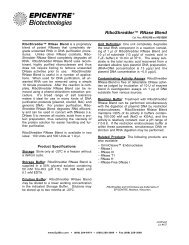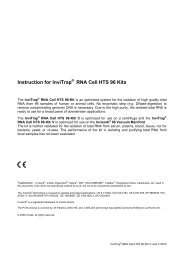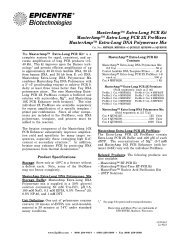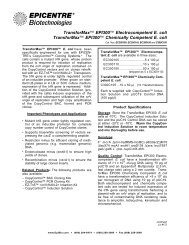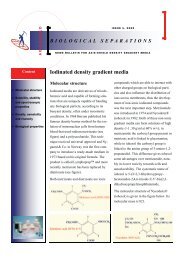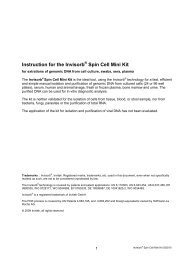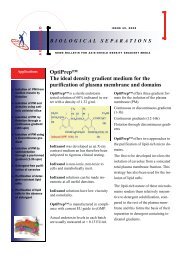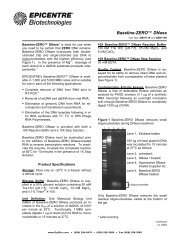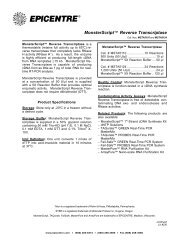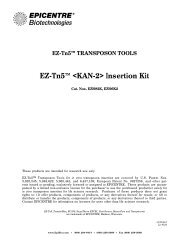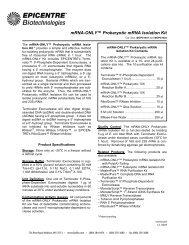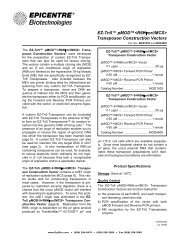Protocol for CopyCutter™ EPI400™ Electrocompetent E. coli ...
Protocol for CopyCutter™ EPI400™ Electrocompetent E. coli ...
Protocol for CopyCutter™ EPI400™ Electrocompetent E. coli ...
Create successful ePaper yourself
Turn your PDF publications into a flip-book with our unique Google optimized e-Paper software.
CopyCutter EPI400 <strong>Electrocompetent</strong> E. <strong>coli</strong><br />
CopyCutter EPI400 Chemically Competent E. <strong>coli</strong><br />
CopyCutter Induction Solution<br />
Cat. Nos. C400EL10, C400CH10, and CIS40025<br />
CopyCutter EPI400 <strong>Electrocompetent</strong> and<br />
Chemically Competent E. <strong>coli</strong> * cells were developed<br />
to significantly lower the copy number of a<br />
wide variety of common vectors so that you can<br />
more readily clone unstable DNA sequences.<br />
Moreover, following a short incubation in the presence<br />
of the CopyCutter Induction Solution,<br />
you can subsequently raise copy number to improve<br />
plasmid yields without compromising stability.<br />
The CopyCutter EPI400 cell line was derived from<br />
our high-trans<strong>for</strong>mation efficiency phage T1-resistant<br />
Trans<strong>for</strong>Max EC100 E. <strong>coli</strong> strain by<br />
manipulating a gene that controls the copy number<br />
of vectors containing ColE1 or pMB1 origins of<br />
replication (e.g., pUC and pET type vectors). This<br />
constitutively expressed gene, pcnB (plasmid<br />
copy number), was deleted from the Trans<strong>for</strong>Max<br />
EC100 strain and replaced with a modified pcnB<br />
gene linked to an inducible promoter, creating the<br />
CopyCutter EPI400 strain.<br />
Additional Benefits:<br />
• High trans<strong>for</strong>mation efficiency with clones of all<br />
sizes.<br />
• Supports blue/white screening of vectors.<br />
• Restriction minus [mcrA (mrr-hsdRMSmcrBC)]<br />
<strong>for</strong> efficient cloning of methylated DNA.<br />
• Endonuclease minus (endA1) to ensure high<br />
yields of plasmid clones.<br />
• Recombination minus (recA1) to ensure the<br />
stability of large cloned inserts.<br />
Product Specifications<br />
Storage: Store CopyCutter EPI400 E. <strong>coli</strong> cells at<br />
–70 o C. The CopyCutter Induction Solution and<br />
pUC19 Control DNA can be stored at either –20 o C<br />
or –70 o C. Warm the CopyCutter Induction Solution<br />
to room temperature and mix thoroughly<br />
be<strong>for</strong>e use.<br />
CopyCutter EPI400 <strong>Electrocompetent</strong><br />
E. <strong>coli</strong><br />
C400EL10 ........ 10 x 50 μl....(10 Electroporations)<br />
CopyCutter EPI400 Chemically Competent<br />
E. <strong>coli</strong>:<br />
C400CH10 .........10 x 50 μl....(10 Trans<strong>for</strong>mations)<br />
Each is supplied with 1 ml (1000X) Copy-<br />
Cutter Induction Solution and 10 μl (100<br />
pg/μl) pUC19 Control DNA<br />
CopyCutter Induction Solution<br />
1000X concentrated solution. Filter sterilized.<br />
CIS40025 ....................................................... 25 ml<br />
Genotype:<br />
F – mcrA (mrr-hsdRMS-mcrBC) 80dlacZ M15<br />
lacX74 recA1 endA1 araD139 (ara, leu)7697<br />
galU galK<br />
– rpsL nupG tonA pcnB dhfr.<br />
Quality Control:<br />
• The electrocompetent CopyCutter EPI400<br />
E. <strong>coli</strong> have a trans<strong>for</strong>mation efficiency of<br />
> 1 x 10 10 cfu/μg DNA using 10 pg of pUC19 and<br />
an Eppendorf Multiporator with setting of 2.5 KV<br />
at 5 milliseconds, fast charge rate using 2-mm<br />
cuvettes.<br />
• The chemically competent CopyCutter EPI400<br />
E. <strong>coli</strong> have a trans<strong>for</strong>mation efficiency of<br />
> 1 x 10 7 cfu/μg DNA using 10 pg of pUC19.<br />
• Both CopyCutter EPI400 E. <strong>coli</strong> cell types are<br />
tested <strong>for</strong> copy number repression and induction<br />
using trans<strong>for</strong>mants harboring pUC19.<br />
• Both CopyCutter EPI400 E. <strong>coli</strong> cell types are<br />
tested to be free of contaminating DNA rendering<br />
resistance to ampicillin, tetracycline, kanamycin<br />
and chloramphenicol.<br />
• Both CopyCutter EPI400 E. <strong>coli</strong> cell types are<br />
tested <strong>for</strong> bacteriophage T1 resistance: genotypically,<br />
by diagnostic PCR of the tonA gene,<br />
and phenotypically by resistance to bacteriophage<br />
T5 infection.<br />
continued<br />
Lit. #219<br />
726 Post Road, Madison, WI 53713 • www.EpiBio.com • (800) 284-8474 • (608) 258-3080 • Fax (608) 258-3088
EPICENTRE<br />
CopyCutter EPI400 <strong>Electrocompetent</strong> E. <strong>coli</strong><br />
CopyCutter EPI400 Chemically Competent E. <strong>coli</strong><br />
CopyCutter Induction Solution<br />
General Considerations<br />
1. Copy number variability: The copy number of vectors containing ColE1 or pMB1-based origins in<br />
the CopyCutter EPI400 strain is dependent on several different factors, including the type of vector<br />
used as well as the size and orientation of the cloned insert. As an example, the table below compares<br />
the copy number of three different cloning vectors in the CopyCutter EPI400 strain compared to<br />
the parental Trans<strong>for</strong>Max EC100 strain.<br />
Table 1. Comparing Plasmid Load in CopyCutter EPI400 and Trans<strong>for</strong>Max EC100 E. <strong>coli</strong> Cells.<br />
E. <strong>coli</strong> Host Cells Growth Condition<br />
+<br />
Approximate Number of Vector Copies Per Cell<br />
pUC19 (Amp) pBR322 (Amp) pET9 (Kan)<br />
Trans<strong>for</strong>Max EC100 cells Normal ~216 ~71 ~33<br />
CopyCutter EPI400 cells Uninduced ~9 ~17 ~9<br />
CopyCutter EPI400 cells Induced ~200 ~66 ~19<br />
+<br />
Based on the molar amount of plasmid DNA obtained from at least 10 10 ampicillin or kanamycin<br />
resistant cells. Cultures were grown overnight in selective media (EC100 and EPI400-uninduced) or<br />
induced <strong>for</strong> 4 hours with the CopyCutter Induction Solution.<br />
2. Random plasmid distribution: Plasmids containing ColE1 or pMB1-based origins are randomly distributed<br />
to daughter cells during cell division. Consequently, some daughter cells will receive plasmids<br />
and others will not. The number of plasmid-free cells in a CopyCutter culture can vary from 10-<br />
60%, dependent on the copy number of the vector and the type of antibiotic used <strong>for</strong> selection.<br />
Kanamycin selection, <strong>for</strong> example, results in many fewer plasmid-free cells than ampicillin selection.<br />
3. Tetracycline selection: Using CopyCutter cells to lower the copy number of vectors that require<br />
tetracycline selection is not recommended<br />
page 2
EPICENTRE<br />
CopyCutter EPI400 <strong>Electrocompetent</strong> E. <strong>coli</strong><br />
CopyCutter EPI400 Chemically Competent E. <strong>coli</strong><br />
CopyCutter Induction Solution<br />
A. Electroporation of CopyCutter EPI400 <strong>Electrocompetent</strong> E <strong>coli</strong><br />
1. DNA should be in water or very low salt buffer (e.g. TE Buffer: 10 mM Tris-HCl [pH 7.5], 1 mM EDTA)<br />
to prevent arcing during electroporation. The pUC19 Control DNA is provided in TE at 100 pg/µl. If<br />
running a trans<strong>for</strong>mation control, dilute the pUC19 Control DNA 1:10 (to a final concentration of<br />
10 pg/µl) with sterile, deionized water and use 1 µl <strong>for</strong> electroporation.<br />
2. Prepare 1 ml of LB medium (do not include antibiotic in the medium) <strong>for</strong> each electroporation to be<br />
per<strong>for</strong>med. This medium will be used <strong>for</strong> post-electroporation outgrowth of trans<strong>for</strong>med cells. Maintain<br />
the medium at room temperature.<br />
3. Pre-chill electroporation cuvettes.<br />
4. Set-up the electroporation device according to the manufacturer's recommendations <strong>for</strong> bacterial<br />
(E. <strong>coli</strong>) electroporation.<br />
5. Thaw CopyCutter EPI400 <strong>Electrocompetent</strong> E. <strong>coli</strong> cells on ice. Mix by gentle tapping or vortexing.<br />
Use the cells immediately. Unused cells can be refrozen at –70 o C. Note: Refrozen cells may have<br />
reduced trans<strong>for</strong>mation efficiency.<br />
6. Transfer the desired amount of DNA to 50 µl of chilled cells. Note: A smaller volume of cells can be<br />
used based on the needs and experiences of the user. Mix the cells and DNA thoroughly but gently<br />
so as not to introduce air bubbles.<br />
7. Transfer the cell/DNA mix to the electroporation cuvette. Be sure that there are no air bubbles in the<br />
cuvette. Wipe the cuvette of any condensation. Place into the electroporator and apply the electric<br />
pulse at the manufacturer's recommendations <strong>for</strong> bacterial (E. <strong>coli</strong>) electroporation.<br />
8. Immediately after electroporation, add 950 µl of room temperature LB medium [Hanahan, D., (1983)<br />
J. Mol. Biol., 166, 557] to the cuvette. Mix gently by pipetting up and down 2-3 times.<br />
9. Transfer the cells to a 15 ml tube and incubate at 37 o C with shaking at 220-230 rpm <strong>for</strong> 1 hour to<br />
recover the cells and allow expression of the antibiotic resistance marker.<br />
10. Dilute and plate the cells on appropriate medium (e.g. LB agar plates) and antibiotic. For cells trans<strong>for</strong>med<br />
with the pUC19 Control DNA, plate on LB agar containing 100 µg/ml of ampicillin. The<br />
remaining cell outgrowth can be stored at 4 o C in the event additional cell dilutions are plated.<br />
Control (Optional): Dilute the control reaction 1:20 and plate 100 µl (equivalent to 0.05 pg DNA) to<br />
LB-ampicillin (100 µg/ml) plates. If 250 colonies are observed on the plate, the trans<strong>for</strong>mation efficiency<br />
is 5 x 10 9 cfu/ µg or [(250 cfu/0.05 pg DNA) x (10 6 pg/µg)].<br />
page 3
EPICENTRE<br />
CopyCutter EPI400 <strong>Electrocompetent</strong> E. <strong>coli</strong><br />
CopyCutter EPI400 Chemically Competent E. <strong>coli</strong><br />
CopyCutter Induction Solution<br />
B. Trans<strong>for</strong>mation of CopyCutter EPI400 Chemically Competent E. <strong>coli</strong><br />
Two procedures <strong>for</strong> trans<strong>for</strong>ming the CopyCutter EPI400 Chemically Competent E. <strong>coli</strong> are presented.<br />
The Standard Trans<strong>for</strong>mation Procedure will provide the highest trans<strong>for</strong>mation efficiency. The 5<br />
Minute Trans<strong>for</strong>mation Procedure is more rapid but may yield 10-fold or more lower trans<strong>for</strong>mation efficiency.<br />
The 5 Minute Trans<strong>for</strong>mation Procedure should only be used with ampicillin selection of the<br />
clones. Both procedures were written <strong>for</strong> trans<strong>for</strong>mation of 50 µl of CopyCutter EPI400 Chemically Competent<br />
E. <strong>coli</strong> (Note: Once thawed, do not refreeze the cells.). A different volume of cells can also be<br />
used based on the experiences and needs of the user.<br />
Standard Trans<strong>for</strong>mation Procedure<br />
1. Prepare 250 µl of SOC medium [Hanahan, D., (1983) J. Mol. Biol., 166, 557] <strong>for</strong> each trans<strong>for</strong>mation<br />
to be per<strong>for</strong>med. Maintain the media at room temperature.<br />
2. Heat a water bath or other temperature-controlled apparatus to 42 o C.<br />
3. Thaw the appropriate number of tubes of CopyCutter EPI400 Chemically Competent E. <strong>coli</strong> cells on<br />
ice. Mix by gentle tapping. Use the cells immediately.<br />
4. Transfer 1-5 µl of DNA or ligation reaction into each tube. Cap the tubes and incubate on ice <strong>for</strong> 5-30<br />
minutes.<br />
5. Transfer the tubes to 42 o C and heat shock <strong>for</strong> 30 seconds.<br />
6. Transfer the cells back to ice and cool <strong>for</strong> 2 minutes.<br />
7. Remove the cover of the tubes and add 250 µl of SOC Media.<br />
8. Recover the cells by incubating at 37 o C <strong>for</strong> 60 minutes with horizontal shaking (e.g. 225 rpm).<br />
9. Plate the cells on the appropriate media and antibiotic, and grow overnight at 37 o C.<br />
5 Minute Trans<strong>for</strong>mation Procedure<br />
The rapid 5 minute trans<strong>for</strong>mation procedure may yield 10-fold or more lower trans<strong>for</strong>mation efficiency<br />
than the Standard Trans<strong>for</strong>mation Procedure described above. Importantly, only selection with ampicillin<br />
can be used with the 5 Minute Trans<strong>for</strong>mation Procedure.<br />
1. Thaw the appropriate number of tubes of CopyCutter EPI400 Chemically Competent E. <strong>coli</strong> cells on<br />
ice. Mix by gentle tapping. Use the cells immediately.<br />
2. Transfer 3-5 µl of DNA or ligation reaction into each tube. Cap the tubes and incubate on ice <strong>for</strong> 5<br />
minutes.<br />
3. Spread the entire cell/DNA mixture onto a pre-warmed LB+ampicillin (100 µg/ml) plate and grow<br />
overnight at 37 o C.<br />
page 4
EPICENTRE<br />
CopyCutter EPI400 <strong>Electrocompetent</strong> E. <strong>coli</strong><br />
CopyCutter EPI400 Chemically Competent E. <strong>coli</strong><br />
CopyCutter Induction Solution<br />
C. Rapid Screening of CopyCutter EPI400 Clones<br />
Plasmids in CopyCutter EPI400 cells can be screened <strong>for</strong> the correct insert size using small amounts of<br />
either uninduced or induced cells. A PCR-based screen is generally used to analyze uninduced clones<br />
since there are so few plasmid copies per cell. We recommend the Colony Fast-Screen Kit (PCR<br />
Screen) <strong>for</strong> preparing PCR-ready DNA in 10 minutes directly from colonies on a plate. Visit http://www.<br />
epibio.com/item.asp?ID=401 <strong>for</strong> more in<strong>for</strong>mation on this product.<br />
To rapidly screen induced CopyCutter EPI400 clones, we recommend the Colony Fast-Screen Kit (Size<br />
Screen). Briefly, colony picks are induced in microcentrifuge tubes, processed using the Colony Fast-<br />
Screen Kit (Size Screen), and analyzed by agarose gel electrophoresis. The size of the cloned insert is<br />
determined by comparing the migration of the supercoiled plasmid DNA with a size-standard of<br />
supercoiled DNAs. A modified Colony Fast-Screen Kit (Size Screen) protocol is given below and more<br />
in<strong>for</strong>mation on this product can be found at http://www.epibio.com/item.asp?ID=272.<br />
1. For each colony to be screened, prepare 300 µl of LB medium + antibiotic in a 1.5 ml microcentrifuge<br />
tube.<br />
2. Using a sterile tip transfer a portion of the colony into one of the 1.5-ml tubes. Note: If the colony size<br />
is = 1 mm diameter, pick the whole colony; if the size is > 1 mm diameter, only pick approximately half<br />
of the colony, because too much cell material may interfere with the screening process.<br />
3. Incubate at 37 o C <strong>for</strong> 30 minutes with vigorous shaking. Important: Vigorous shaking is crucial! For<br />
example, tape the tubes horizontally to the shaker. Placing the tubes in a rack and taping the rack to<br />
the bottom of the shaker is not sufficient.<br />
4. After 30 minute incubation, transfer 100 µl of the cell cultures into separate 1.5 ml microcentrifuge<br />
tubes. These 100 µl aliquots can be used as inocula <strong>for</strong> the clone induction process. Do not add the<br />
CopyCutter Induction Solution to these tubes.<br />
5. To the remaining 200 µl, add 0.2 µl of thawed and thoroughly mixed 1000X CopyCutter Induction<br />
Solution (or 2 µl of a 1:10 dilution of the CopyCutter Induction Solution in sterile water) to a final concentration<br />
of 1X.<br />
6. Shake both sets of tubes very vigorously <strong>for</strong> 4 to 5 hours at 37 o C. Important: Vigorous shaking is<br />
crucial! For example, tape the tubes horizontally to the shaker. Placing the tubes upright in a rack is<br />
not sufficient. Store the tubes containing the 100 µl aliquot at 4 o C. Note: If these cells are not going<br />
to be used within 48 hours, streak them onto an LB + antibiotic plate <strong>for</strong> long term storage.<br />
7. Spin down the cells from the induced 200 µl of cell cultures, <strong>for</strong> 5 minutes at 12,500 rpm.<br />
8. Discard the supernatant carefully, so as not to disturb the cell pellet. Resuspend the cell pellets in<br />
15 µl of the EpiBlue Solution. Vortex to completely resuspend the cells. It is critical to completely<br />
resuspend the cell pellets to maximize the amount of DNA released from the cells.<br />
9. Add 15 µl of the EpiLyse Solution, vortex vigorously and heat 10 minutes at 70 o C.<br />
page 5
EPICENTRE<br />
CopyCutter EPI400 <strong>Electrocompetent</strong> E. <strong>coli</strong><br />
CopyCutter EPI400 Chemically Competent E. <strong>coli</strong><br />
CopyCutter Induction Solution<br />
10. Load 15 µl of the lysed cell solutions on the appropriate percentage agarose gel. If the lysed cell<br />
solutions are too viscous to load onto a gel, add more EpiLyse Solution until loading is manageable.<br />
It is important to make sure the lysed cell solution stay in the wells since the viscous solution may be<br />
easily pulled out of the wells when retracting the pipette tips. The remaining lysed cell solutions can<br />
be stored at room temperature <strong>for</strong> up to 1 week in the event additional gels are run.<br />
11. Load the appropriate volume of a supercoiled DNA size marker (not supplied in the kit), to lanes of<br />
the gel adjacent to the lysed cell extracts. Run the gel <strong>for</strong> 45-60 minutes. Stain with a 1:10 4 dilution<br />
of SYBR ® Gold in gel running buffer or water, or prolonged staining with ethidium bromide.<br />
D. Inducing CopyCutter EPI400 Clones to High Copy Number<br />
1. To prepare inocula <strong>for</strong> the induction process, add 5 ml of LB + antibiotic to a 15 ml tube. Inoculate<br />
with an isolated colony or use 5-10 µl from Step C:6. Shake overnight at 37 o C.<br />
2. The induction process can be done in any culture volume desired depending on user need. Dilute the<br />
overnight culture 1:10 and measure the OD 600 . Based on this reading, dilute the overnight culture to<br />
a final OD 600 of 0.2 in LB + antibiotic + 1X CopyCutter Induction Solution.<br />
For example, if the undiluted overnight culture has an OD 600 of 2.70 then add 3.7 ml of the overnight<br />
to 50 ml of LB + antibiotic + 1X CopyCutter Induction Solution.<br />
3. Incubate at 37 o C <strong>for</strong> 4 hours with vigorous shaking. Important: Vigorous shaking is crucial <strong>for</strong> the<br />
best possible induction of copy number. Aeration of the induction cultures is critical. There<strong>for</strong>e, to<br />
maximize the surface area of the culture solution in the tube, per<strong>for</strong>m the induction in the largest volume<br />
tubes that reasonably meets your needs and resources. Induce clones to high copy number in a<br />
5 ml cultures in at least 15 ml tubes, and 50 ml cultures in at least 125 ml flasks.<br />
4. Isolate plasmid DNA from the induced culture by your method of choice.<br />
SYBR is a registered trademark of Molecular Probes, Inc., Eugene, Oregon.<br />
CopyCutter, EPI400, Trans<strong>for</strong>Max, EC100, Fast-Screen, EpiBlue, and EpiLyse<br />
are trademarks of EPICENTRE, Madison, Wisconsin.<br />
* CopyCutter E. <strong>coli</strong> Cells are covered by one or more patent applications assigned to EPICENTRE. These products<br />
are accompanied by a limited non-exclusive license <strong>for</strong> the purchaser to use the purchased products solely <strong>for</strong><br />
life science research. Purchase of these products does not grant rights to: (1) offer products, components of<br />
products or any derivatives thereof <strong>for</strong> resale; or (2) to distribute or transfer the products, components of products,<br />
or any derivatives thereof to third parties. Contact EPICENTRE concerning licenses <strong>for</strong> other uses.<br />
page 6 11/09




